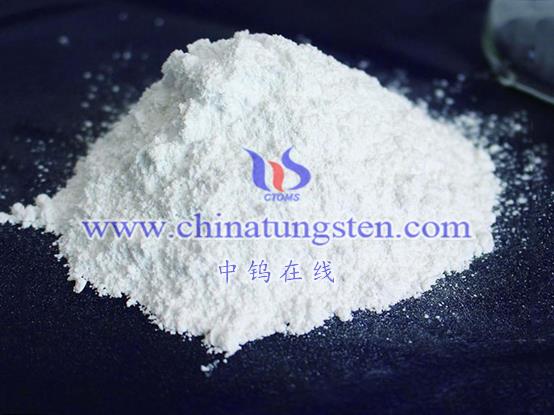Nano tungsten oxide is powder metallurgy raw material for producing tungsten carbide and tungsten products. Through powder metallurgy, tungsten carbide, cemented carbide, super-hard molds and tungsten rods, tungsten wires, etc. It can also be used in X-ray screens and fireproof fabrics, as well as used as coloring agents for ceramics and analytical reagents.
The color of tungsten oxide nanoparticles, in the W – O system, there are tungsten oxides such as WO3, WO 2.9 , WO 2.72, WO2, etc. WO3 (yellow) — WO 2.90 (blue) – WO 2.72 , (violet) – WO2 (brown) – W (grey-black). That is, tungsten has four stable oxides: yellow oxide (WO3), blue oxide (WO2.90), purple oxide (WO2.72), and tan oxide (WO2).
Blue tungsten oxide refers to a series of non-integer-ratio oxides of tungsten. The chemical formula is expressed as WOx, mainly WO2.9. Blue tungsten oxide is used for the production of tungsten powder, doped tungsten powder, tungsten rods and tungsten carbide, UV-resistant, photocatalytic and so on. Blue tungsten oxide will change color when it sees light, it will turn into light blue. It will turn into light blue color, if it is refilled with black opaque bag, it will turn back to its original color.
Nano tungsten trioxide is lemon yellow powder, density 7.2~7.4g/cm3, melting point is about 1470℃, boiling point is between 1700~2000℃, higher than 800℃ when it is significantly sublimated, tungsten trioxide heat of generation 202.8 cal/mol, tungstic anhydride can be slightly soluble in water (0.2g/L), insoluble in all the inorganic acids except hydrofluoric acid. Tungstic acid is readily soluble in caustic solutions (NaOH or KOH) and ammonia to form tungstates [NaWO4, K2WO4 and (NH4)2WO4]. Tungsten trioxide dissolves slowly in ammonia solutions and even more slowly when heated to high temperatures. Tungsten trioxide is easily reduced by various reducing agents. At room temperature, even a small amount of organic matter can reduce it and change its color. But when heated in the air, the original color is restored. At 700~900℃, tungsten trioxide is easily reduced to tungsten metal by hydrogen, carbon monoxide and carbon.
Nano tungsten dioxide is a brown chocolate-like powder, sensitive to moisture. The color changes from light to dark to deep orange when heated, and still returns to the original color when cold. The density is 10.9~11.1g/cm3, the boiling point is about 1700℃, the heat of generation is 134 kcal/mol, and tungsten dioxide is generated by hydrogen reduction of tungsten trioxide at 575~600℃. Tungsten dioxide is insoluble in water, alkali solution, hydrochloric acid and dilute sulfuric acid. Nitric acid can oxidize tungsten dioxide into high-valent oxides. Tungsten dioxide is quickly oxidized to tungsten trioxide in air and becomes a blue oxide when heated to 500°C in nitrogen oxide. At 1020°C into, tungsten dioxide can be reduced to tungsten metal by carbon. At 250~300℃, tungsten trioxide can be reduced with hydrogen or carbon monoxide, and tungsten trioxide can be obtained as powdered purple tungsten oxide (WO2.72) when heated to 200~250℃ in vacuum.
Specific uses of nanometer tungsten oxide:
1) Gas sensitization, catalysis, especially photocatalysis.
2) Solar sensitized thin film.
3) Advanced pigments, oil and watercolor.
4) X-ray shielding and fireproof fabrics.
5) Tungsten doped modified materials for doping.
6) Gas sensing materials.
7) Main or auxiliary catalysts for petrochemicals. Hydrogenation and dehydrogenation, oxidation, hydrocarbon isomerization, alkylation and many other reactions with good catalytic properties, is a common catalyst for petrochemicals.

More details of tungsten oxide product, please visit website: tungsten-oxide.com
Please contact CHINATUNGSTEN for inquiry and order of tungsten oxide:
Email: sales@chinatungsten.com
Tel.: 86 592 5129595






